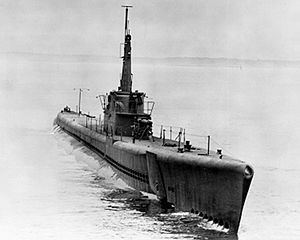Laid down 23 July 1942 Commissioned 20 April 1943 Struck 1 April 1968 Launched 12 November 1942 | Sponsored by Mrs. Lewis Parks Decommissioned 1 November 1946 Construction started 23 July 1942 Length 95 m | |
 | ||
Fate Sold for scrap, 17 March 1971 | ||
USS Billfish (SS-286), a Balao-class submarine, was the first ship of the United States Navy to bear the generic name for any fish, such as gar or spearfish, with bill-shaped jaws. Her keel was laid at Portsmouth Navy Yard on 23 July 1942. She was launched on 12 November 1942 sponsored by Mrs. Lewis Parks (wife of Lieutenant Commander Lew Parks), and commissioned on 20 April 1943 with Lieutenant Commander Frederic C. Lucas, Jr., in command.
Between 12 August 1943 and 27 August 1945 Billfish made eight war patrols out of Pearl Harbor. During these patrols she sank three freighters totaling 4,074 tons and five smaller craft. Part of her seventh and eighth patrols were spent on plane guard duty off Japan.
On 11 November 1943, in the Makassar Strait, a Japanese destroyer severely damaged Billfish with a depth charge attack, driving her to a depth of 650 feet (200 m), some 250 feet (76 m) below her test depth while continuing the attack. Many of the crew were badly injured; Lieutenant Charles W. Rush found himself the senior man still able to carry out his duties. He assumed command and began attempting to escape the attack. Realizing that his boat's damaged fuel tanks were leaking profusely and the enemy was undoubtedly tracking him by the oil slick he was leaving, he reversed course so precisely that he was able to proceed back down his previous track, using the floating oil slick as cover instead of a trail.
Meanwhile, Chief Electrician's Mate John D. Rendernick took action from his battle station and led emergency repairs, which included using a hydraulic jack to reposition the port main motor, which had been knocked off its foundation, and filling a leaking stern torpedo tube with grease.
After 12 hours, the attack ceased. Four hours after that, under the cover of night, Rush surfaced the boat, recharged batteries using the single operating generator, completed repairs, and continued her patrol.
For his actions, Rush earned the Navy Cross. Rendernick was awarded the Navy Silver Star, posthumously, and on 17 August 2004 the Naval Submarine Training Center (NAVSUBTRACEN) John D. Rendernick Damage Control Wet Trainer at Pearl Harbor was named in his honor.
Billfish arrived at Pearl Harbor from her last war patrol on 27 August 1945, and was ordered to the Atlantic. She arrived at New Orleans, Louisiana, on 19 September and spent the next nine months in maneuvers and training. Following inactivation at Portsmouth Navy Yard (June - October 1946) she was towed to New London, Connecticut, by ATR-64 and went out of commission in reserve there 1 November 1946.
Billfish received seven battle stars for her World War II service.
The Billfish, like several other World War II boats, did not end her service at the end of the war. From 1 January 1960 until 1 April 1968 she served as a training vessel for the Naval Reserve, First Naval District, at the South Boston Annex of the Boston Naval Shipyard. She was stricken from the list of Navy ships on 1 April 1968 and subsequently sold for scrapping in 1971.
